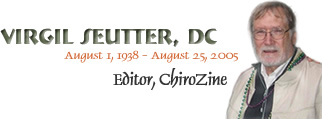


Expect the Appearance of More and Diverse Techniques in the Future of Chiropractic
Virgil J. Seutter, D.C. (23 jul 2005)
The idea that chiropractic is confined to a single protocol (manipulation) and a single target (spine) for treatment has confused both the chiropractor and the medical community. While the chiropractor experimented with manual therapy to the spine, he developed various protocols to examine the spine in an attempt to predict where application of a manipulative thrust should be made. Practically all of his methods were directed toward reductionist evaluation of the spine and the ramifications of a linear, wiring system schema.
The appearance of low-force (soft tissue) techniques (applied kinesiology (AK), sacro-occipital technique (SOT)) in the early years began to develop interest in non-manipulative protocols. While the results of the treatments often appeared dramatic, explanations were not so easy to find. At best, it appeared to be related to a neurological mechanism and that it was probably a nonlinear phenomenon. This latter observation was probably the only explanation for a protocol that often could not be repeated compared to linear analysis of the wiring system and its reducible nature.
What the chiropractor was probably tapping into was the bodies recognition of itself; that communication and self - awareness were a distinct phenomenon linked to the nervous system but different from the motor - sensory division of morphological markers; that while anatomical differentiation was apparent, the synchronization of all function had to be related to a missing link in which self - organization of the organism (or body) required a synchronization of movement coordination that permitted it to function as an independent, autonomous entity.
The missing link, of course, appeared to be the brain and its nonlinear effects upon the body. That we could be dealing with nonlinear characteristics is less speculative today than a few years ago. That we appear to be dealing with communication principles suggest a transition from a wiring system to a nonlinear, communication system; a cognitive system. The use of fMRI further reveals correlations that were previously hidden.
How to examine this nonlinear system has been a puzzle. However, incidental findings began to appear that implicated the possibility of a mathematical correlation of neuro - reflexive activity in the body. This was an indirect way to extrapolate possible hidden function in which the brain could synchronize body movement through a system of reflexive muscle activity. Synchronization was important in movement activity. Speculation suggests that muscle reflexive activity is closely related to a subliminal control mechanism in this synchronization process.
The ability to extract data for analysis is based upon changes in topographical analysis of the body surface. It provides some ability to note changes in the body (organism) when confronted with a spatial contact (touch) to its surface. This is interpreted as change in information content as part of data alteration. This data is digitalized for further analysis.
Noting change in mathematical data has provided some insight into what might be anticipated with "touch" and "response" techniques. That touching the body at a certain spatial area may alter body posture by changing leg length or hip levels in standing observation merely provides mathematical data that can be interpreted as information. This information is further developed into algorithms that allow the practitioner to make further decision in terms of treatment application; that a counter - touch approach (whether touch, as a healing intent, or rubbing a muscle as in massage, or manipulation to bombard the body with impulse changes), should correct or modify an aberrant reflexive observation.
By noting changes in the information patterns, certain conclusions could be made as something just above speculation; that a form of data could be used to construct a new model for critical analysis.
By using this mathematical probability analysis (Spinal Segmental Intersegmental Decoupling (SSID)), it was noted that single spatial contact points on the body surface may be linked to multiple sources in the spine as a nonlinear effort distinct from dermatones or touch that would be traced as a reducible link to an area of the spine. The possibility that we could be dealing with two different systems was suggested by the computer data; that multiple sources from the spine were involved and that treatment to those multiple sources (manipulation using instrument intervention) altered the spatial contact point reflex.
The possibility became more apparent in that while some techniques make claim to the use of a certain product or substance to alter this reflex, the findings question whether one substance could, indeed, be linked to a single spatial contact point. It was found that other substances woud produce a similar result. But, it was also found that often these were temporary and that manual application to the spinal area of manipulation (instrument) in sequence to the levels revealed by the data, produced a change more compatable with permanent, longer lasting responses. Nutritional substances need would change after these applications and no longer be revealed as a 'necessity.' The frequency of treatment became less; economic feasibility for chiropractic intervention more apparent.
The expansion of technique will continue because of the nature of the nervous system; that it is a communication system superimposed upon a linear, wiring system schema. The possibility for deception also exists but likely a result of the illusion created by viewpoints that retain a reducible nature to the subluxation as a linear problem as opposed to a nonlinear perspective. Until the chiropractic community (and science, for that matter), understand the complex relationship between a computational system superimposed upon a wiring system schema, cause - effect relationships may not be completely revealing. (chiro.org; v seutter; 23 jul 2005)


| Home Page | Visit Our Sponsors | Become a Sponsor |
Please read our DISCLAIMER |